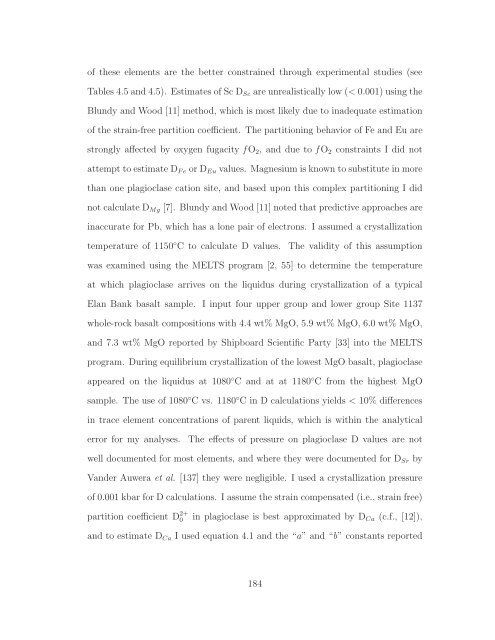TEXTURAL AND MICROANALYSIS OF IGNEOUS ROCKS: TOOLS ...
TEXTURAL AND MICROANALYSIS OF IGNEOUS ROCKS: TOOLS ...
TEXTURAL AND MICROANALYSIS OF IGNEOUS ROCKS: TOOLS ...
Create successful ePaper yourself
Turn your PDF publications into a flip-book with our unique Google optimized e-Paper software.
of these elements are the better constrained through experimental studies (see<br />
Tables 4.5 and 4.5). Estimates of Sc DSc are unrealistically low (< 0.001) using the<br />
Blundy and Wood [11] method, which is most likely due to inadequate estimation<br />
of the strain-free partition coefficient. The partitioning behavior of Fe and Eu are<br />
strongly affected by oxygen fugacity f O2, and due to f O2 constraints I did not<br />
attempt to estimate DFe or DEu values. Magnesium is known to substitute in more<br />
than one plagioclase cation site, and based upon this complex partitioning I did<br />
not calculate DMg [7]. Blundy and Wood [11] noted that predictive approaches are<br />
inaccurate for Pb, which has a lone pair of electrons. I assumed a crystallization<br />
temperature of 1150 ◦ C to calculate D values. The validity of this assumption<br />
was examined using the MELTS program [2, 55] to determine the temperature<br />
at which plagioclase arrives on the liquidus during crystallization of a typical<br />
Elan Bank basalt sample. I input four upper group and lower group Site 1137<br />
whole-rock basalt compositions with 4.4 wt% MgO, 5.9 wt% MgO, 6.0 wt% MgO,<br />
and 7.3 wt% MgO reported by Shipboard Scientific Party [33] into the MELTS<br />
program. During equilibrium crystallization of the lowest MgO basalt, plagioclase<br />
appeared on the liquidus at 1080 ◦ C and at at 1180 ◦ C from the highest MgO<br />
sample. The use of 1080 ◦ C vs. 1180 ◦ C in D calculations yields < 10% differences<br />
in trace element concentrations of parent liquids, which is within the analytical<br />
error for my analyses. The effects of pressure on plagioclase D values are not<br />
well documented for most elements, and where they were documented for DSr by<br />
Vander Auwera et al. [137] they were negligible. I used a crystallization pressure<br />
of 0.001 kbar for D calculations. I assume the strain compensated (i.e., strain free)<br />
partition coefficient D 2+<br />
0 in plagioclase is best approximated by DCa (c.f., [12]),<br />
and to estimate DCa I used equation 4.1 and the “a” and “b” constants reported<br />
184
















